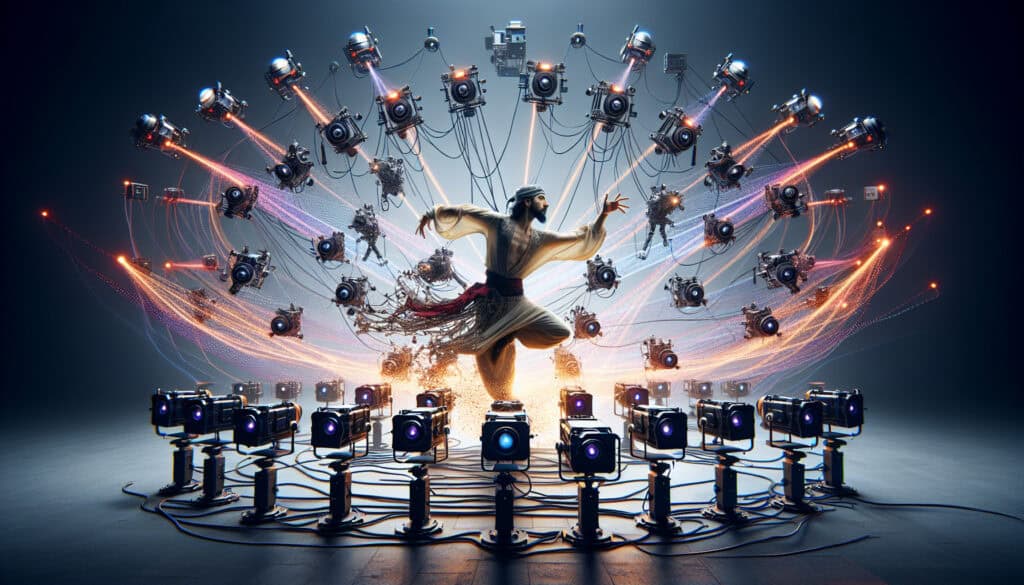Registrare il movimento di oggetti o persone.
- Metodologie: Ingegneria, Ergonomia
Sistemi di cattura del movimento

Sistemi di cattura del movimento
- Progettazione per la produzione additiva (DfAM), Gemello digitale, Ergonomia, Fattori umani, Human-Centered Design, Prototipazione, Robotica, Simulazione
Obiettivo:
Come si usa:
- Una tecnologia per registrare il movimento umano e tradurlo in formato digitale. Viene utilizzata in diverse applicazioni, dall'intrattenimento allo sport, dalla medicina all'ingegneria.
Professionisti
- Fornisce dati dettagliati e precisi sul movimento umano; può essere utilizzato per creare animazioni e simulazioni realistiche.
Contro
- Possono essere costosi e complessi da installare e utilizzare; i marcatori possono essere intrusivi e possono influenzare il movimento della persona.
Categorie:
- Ingegneria, Ergonomia, Progettazione del prodotto
Ideale per:
- Analizzare il movimento di un atleta per migliorarne le prestazioni, o il movimento di un lavoratore per progettare un sistema più ergonomico. postazione di lavoro.
I sistemi di acquisizione del movimento servono numerosi settori, tra cui il cinema, i videogiochi, la realtà virtuale, la biomeccanica, la riabilitazione e l'interazione uomo-macchina. Nel settore dell'intrattenimento, la tecnologia facilita la creazione di animazioni e personaggi realistici nei film e nei videogiochi, consentendo ai registi e agli sviluppatori di giochi di tradurre i movimenti umani reali in formati digitali. Nella scienza dello sport, il motion capture viene utilizzato per analizzare le prestazioni degli atleti catturando la loro biomeccanica, aiutando così allenatori e preparatori a perfezionare le tecniche e a ridurre i rischi di infortunio. I professionisti della sanità utilizzano la cattura del movimento per valutare i modelli di movimento dei pazienti a fini riabilitativi, analizzando come ottimizzare il loro recupero attraverso programmi di fisioterapia su misura. Gli ingegneri sfruttano questa tecnologia per progettare prodotti ergonomici, assicurandosi che gli strumenti, le postazioni di lavoro e persino i veicoli migliorino il comfort dell'utente, riducendo al minimo le sollecitazioni e le lesioni. Il processo prevede la collaborazione di animatori, analisti biomeccanici, terapisti e progettisti di prodotti che raccolgono dati attraverso telecamere e sensori posizionati sui soggetti, traducendoli in informazioni utili per l'innovazione in questi settori. La capacità di fornire dati precisi consente un miglioramento continuo attraverso la progettazione iterativa, rendendola una metodologia preziosa per i team che cercano di migliorare le esperienze degli utenti o i risultati delle prestazioni.
Fasi chiave di questa metodologia
- Selezionare la tecnologia di cattura del movimento appropriata in base ai requisiti dell'applicazione. <li.Configurare l'ambiente di acquisizione del movimento, assicurando condizioni ottimali di illuminazione e spazio. <li.Impostare i marcatori sui soggetti o sui segmenti del corpo in base alle specifiche esigenze di tracciamento. <li.Eseguire la calibrazione del sistema per garantire un'accurata acquisizione spaziale 3D dei movimenti. <li.Eseguire le acquisizioni di prova per verificare la precisione del sistema e la visibilità dei marcatori. <li.Registrare sequenze di movimento durante varie attività, assicurando l'acquisizione dei movimenti rilevanti. <li.Elaborare i dati grezzi utilizzando il software di acquisizione del movimento per tradurre i movimenti in modelli digitali. <liAnalizzare i dati elaborati per valutare i modelli di movimento e identificare le aree di miglioramento. <liIntegrare i dati sul movimento in strumenti di simulazione o di progettazione per ulteriori analisi o valutazioni ergonomiche. <liIterare le raccomandazioni sulla progettazione o sulle prestazioni in base ai risultati dell'analisi.
Suggerimenti per i professionisti
- Incorporare algoritmi avanzati di filtraggio e apprendimento automatico nella pipeline di elaborazione dei dati per migliorare l'accuratezza dell'analisi del movimento e identificare modelli di movimento sottili.
- Utilizzare un approccio ibrido per la cattura del movimento, che combina sistemi ottici e inerziali, per migliorare la robustezza dei dati e la sicurezza. versatilità in vari ambienti.
- Impegnarsi in collaborazione interdisciplinare con esperti di biomeccanica per interpretare i dati in modo da fornire raccomandazioni attuabili per il miglioramento delle prestazioni o la progettazione ergonomica.
Leggere e confrontare diverse metodologie, raccomandiamo il
> Ampio archivio di metodologie <
insieme ad altre 400 metodologie.
I vostri commenti su questa metodologia o ulteriori informazioni sono benvenuti su sezione commenti qui sotto ↓ , così come tutte le idee o i link relativi all'ingegneria.
Contesto storico
1986
(se la data non è nota o non è rilevante, ad esempio "meccanica dei fluidi", viene fornita una stima approssimativa della sua notevole comparsa)

Post correlati
Meta-analisi
Mappatura dei messaggi
Diagrammi del modello mentale
Forze di spinta e di trazione massime accettabili
Pianificazione dei fabbisogni di materiale (MRP)
Programma di produzione principale (MPS)